 Last additions - MIE 三重県 Last additions - MIE 三重県 |
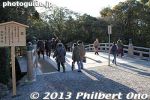
Path to Geku. 第一鳥居口参道Jan 14, 2013
|
|
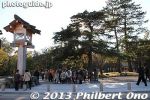
Geku entrance. Toyouke Omikami is also the god for food, clothing, and shelter. Geku was founded about 1,500 years ago.Jan 14, 2013
|
|

Geku is Ise Jingu's Outer Shrine (officially named "Toyouke Daijingu"). It is one of the two main shrines of Ise Jingu. Geku worships the god Toyouke Omikami, who is responsible for the food of Amaterasu Omikami worshipped at Naiku.Jan 14, 2013
|
|
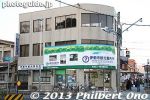
Ise Tourist Information across from the Geku entrance. Very helpful.Jan 14, 2013
|
|
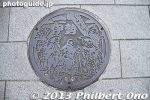
Ise manhole depicting Ise Jingu pilgrims. Mie Pref.Jan 14, 2013
|
|
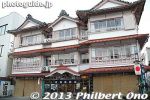
Old ryokan inn.Jan 14, 2013
|
|

Sando path from Ise-shi Station to Ise Jingu Shrine's Geku Outer Shrine. A short walk. You're supposed to visit Geku before Naiku.Jan 14, 2013
|
|
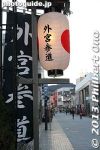
I noticed that Geku was much less crowded than Naiku and apparently most people visit Naiku only. Lantern along the path to Geku.Jan 14, 2013
|
|
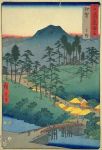
Hiroshige's woodblock print of Iga-Ueno from his "Famous Views of the 60 Provinces" series. The castle can be seen in the distance.Apr 24, 2011
|
|

Hiroshige's woodblock print of Kuwana (43rd post town on the Tokaido) from his "Fifty-Three Stations of the Tokaido Road" series. People traveling by boat to Kuwana from Miya.Apr 24, 2011
|
|

Ueno-shi StationJul 06, 2009
|
|

Apr 28, 2009
|
|

Apr 28, 2009
|
|

Inside Iga Ueno Danjiri Museum.Apr 28, 2009
|
|

Iga Ueno Danjiri MuseumApr 28, 2009
|
|
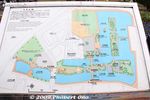
Map of Kyuka Park on the site of Kuwana Castle.Apr 27, 2009
|
|

Site of Kuwana-juku's Honjin.Apr 27, 2009
|
|

Ibigawa RiverApr 27, 2009
|
|

Next to Shichiri-no-watashi was Kuwana-juku's Waki-Honjin.Apr 27, 2009
|
|

Kyuka Park moat near Shichiri-no-watashi.Apr 27, 2009
|
|

Shichiri-no-watashi made Kuwana properous and busy with travelers. This is a Shichiri-no-watashi marker.Apr 27, 2009
|
|

The controversial Nagaragawa Dam. The Nagaragawa River and Ibi River run parallel to each other in this area until they merge as the Ibi River.Apr 27, 2009
|
|

Tokaido Road in Kuwana-juku.Apr 27, 2009
|
|

Next to the Waki-Honjin was the Honjin whose site is now occupied by this building.Apr 27, 2009
|
|

Sign explaining Kuwana's Honjin and Waki-Honjin.Apr 27, 2009
|
|

Shichiri-no-watashi at Kuwana, Mie. Adjacent to Kyuka Park is the Kuwana-juku post town on the Tokaido Road. The building on the right is on the site of the Waki-Honjin.Apr 27, 2009
|
|

Apr 27, 2009
|
|

Building on the site of Kuwana-juku's Waki-Honjin. It is a ryokan inn.Apr 27, 2009
|
|

Ibi RiverApr 27, 2009
|
|

Apr 27, 2009
|
|

The second floor is a small exhibition room and small windows.Apr 27, 2009
|
|

The 28-km ocean crossing from Miya-juku to Kuwana took about 4 hours. It was often perilous with rough waters. Apr 27, 2009
|
|

Shichiri-no-watashi at Kuwana, Mie. This is where travelers arrived by boat after crossing the ocean for four hours from Miya-juku near Atsuta Shrine in Aichi. 七里の渡しApr 27, 2009
|
|

Site of Kanbe turret.Apr 27, 2009
|
|

Lookimg like a castle turret is this water sluice gate management building.Apr 27, 2009
|
|

Sakura Matsuri posterApr 27, 2009
|
|

Apr 27, 2009
|
|

Site of Tatsumi turret.Apr 27, 2009
|
|

Apr 27, 2009
|
|

Apr 27, 2009
|
|

Apr 27, 2009
|
|

Apr 27, 2009
|
|

Apr 27, 2009
|
|

Apr 27, 2009
|
|

Apr 27, 2009
|
|

Apr 27, 2009
|
|

Many red bridges at Kyuka Park.Apr 27, 2009
|
|

Apr 27, 2009
|
|

Apr 27, 2009
|
|

Apr 27, 2009
|
|

Apr 27, 2009
|
|

Apr 27, 2009
|
|

These blossoms were 1 or 2 days before reaching full bloom in early April.Apr 27, 2009
|
|

Kyuka Park cherry blossoms in Kuwana, Mie.Apr 27, 2009
|
|

Noted for cherry blossoms, Kyuka Park is on the site of Kuwana Castle which was occupied by Honda Tadakatsu. Apr 27, 2009
|
|

Way to Honmaru, the central part of the castle.Apr 27, 2009
|
|

Honmaru of Kuwana Castle. No castle buildings remain. Only moats and turret foundations. A shrine occupies much of the Honmaru area.Apr 27, 2009
|
|

Statue of Lord Honda Tadakatsu at Kyuka Park, site of his Kuwana Castle.Apr 27, 2009
|
|

The best part of Kyuka Park is in the Ninomaru area.Apr 27, 2009
|
|

Noted for cherry blossoms, Kyuka Park is on the site of Kuwana Castle which was occupied by Honda Tadakatsu.Adjacent to the park is the Kuwana-juku post town on the Tokaido Road that welcomed visitors after they crossed the ocean (Shichiri-no-watashi) from Miya-juku in Aichi. Photo: Kuwana sign at Kuwana Station.Apr 27, 2009
|
|

Statue of Lord Honda Tadakatsu at Kyuka Park. 本多忠勝Apr 27, 2009
|
|

The line's train tracks has an extra narrow gauge.Apr 24, 2009
|
|
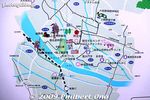
Map of Toin town, Mie. Many thanks to my friends Tomoyo and Shunji in Toin-cho for taking me to see this festival.Apr 24, 2009
|
|

Oyashiro Festival poster.Apr 24, 2009
|
|

My camera was fine. Nothing broken, but the edge of my lens filter had a slight dent...Apr 24, 2009
|
|

Toin Station on the Sangi Railway Hokusei Line.Apr 24, 2009
|
|

The narrow gauge makes the trains narrower too.Apr 24, 2009
|
|

Here he comes, ready to toss his baton. Now I was watching this through my camera lens and shooting continuously at 6 frames per sec.Apr 24, 2009
|
|

This rider I will never forget.Apr 24, 2009
|
|

The moment after this shot was taken, this baton hit my camera lens and bounced off. A kid nearby quickly picked up the dropped baton. That's okay, I let him have it. My gift to the local people.Apr 24, 2009
|
|

And so all these people are waving their arms shouting, "Toss it to me!" Also see my YouTube video here.Apr 24, 2009
|
|

He waves it around before tossing it.Apr 24, 2009
|
|

It must be fun to ride that fast.Apr 24, 2009
|
|
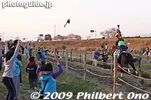
He tosses the baton.Apr 24, 2009
|
|

They kept riding back and forth until twilight. Toward the end, they tossed these batons to people.Apr 24, 2009
|
|

This event is called yabusame. Although they wear arrows on their backs, they do not shoot any arrows while riding. They just gallop straight along the course.Apr 24, 2009
|
|

One end of the riding course.Apr 24, 2009
|
|

Apr 24, 2009
|
|

One rider waves around his baton before tossing it. This lucky little girl got one.Apr 24, 2009
|
|

The other end of the riding course. Apr 24, 2009
|
|

This is one end of the riding course. Apr 24, 2009
|
|

The jockeys galloped through the course several times.Apr 24, 2009
|
|

Apr 24, 2009
|
|

Apr 24, 2009
|
|

One of the jockeys shoots an arrow toward the river.Apr 24, 2009
|
|

Apr 24, 2009
|
|

Horse riding ground (baba). It looks like 500 meters or so.Apr 24, 2009
|
|

Apr 24, 2009
|
|

Apr 24, 2009
|
|

One of the riders.Apr 24, 2009
|
|

Apr 24, 2009
|
|

Apr 24, 2009
|
|

The group of men sing for the rider.Apr 24, 2009
|
|

Apr 24, 2009
|
|

Apr 24, 2009
|
|

Shrine priestApr 24, 2009
|
|

Apr 24, 2009
|
|

Apr 24, 2009
|
|

On SUnday, the second half of the festival is a procession from Inabe Shrine to a horse riding ground nearby at 3 pm. The yabusame horseback riding is then held at 3:30 pm.Apr 24, 2009
|
|

Apr 24, 2009
|
|

Rider and his hat.Apr 24, 2009
|
|

Apr 24, 2009
|
|

And there he is.Apr 24, 2009
|
|

The procession crosses the river and heads for the horse riding ground. 神霊渡御Apr 24, 2009
|
|

Inabe Shrine's statue of a sacred horse near the horse riding ground.Apr 24, 2009
|
|

This is definitely one of the more unique and exciting festivals I have seen in Japan. I have to give much credit to these young and brave lads.Apr 24, 2009
|
|

Riders make a "victory lap" within the shrine grounds.Apr 24, 2009
|
|

The victorious rider holds out a fan and sings a victory song. People celebrate the imminent abundant harvest.Apr 24, 2009
|
|
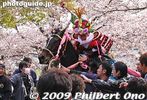
The rider looks relieved, and proud to have a lifetime memory.Apr 24, 2009
|
|

Apr 24, 2009
|
|

This is what the top of the incline looks like. A bunch of people wait for the horse to come up.Apr 24, 2009
|
|

The horse makes a nice leap up.Apr 24, 2009
|
|
|
|

The running course is quite short, maybe 100-150 meters. It cannot be too long or else the horse will get too tired to make the final leap.Apr 24, 2009
|
|

Apr 24, 2009
|
|

This horse was the most successful of the day. It made a clean leap in one try.Apr 24, 2009
|
|

There he goes.Apr 24, 2009
|
|

Rider with hat bearing an iris flower prepares to mount.Apr 24, 2009
|
|

After a few hind-leg kicks, the horse manages to go over. When the horse goes over, it is an omen that this year's harvest will be abundant. Imagine the enormous pressure on the rider to go over the top.Apr 24, 2009
|
|
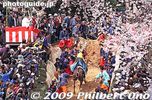
And there he goes up on the incline.Apr 24, 2009
|
|

This is near the start of the course where the rider gets on the horse.Apr 24, 2009
|
|

Next horse up. In the past, they spiked the horse with stimulants to make it more excited, but they discontinued that practice.Apr 24, 2009
|
|

The next rider is prepared. He sits in a sacred compartment, gets his hanagasa hat adjusted, and waits for his horse to arrive. He was stern-faced. There's a 15-20 min. break between each Ageuma run.Apr 24, 2009
|
|
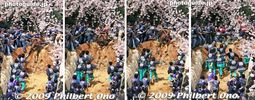
The horse gets stuck as its hind legs cannot push off from any surface. It kept kicking its hind legs as it desperately tried to get over the embankment and it finally did. This was the first run of the day on Sunday.Apr 24, 2009
|
|
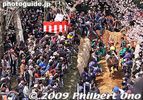
The horse approaches the steep wall.Apr 24, 2009
|
|
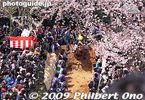
Apr 24, 2009
|
|

The horse makes it over the top. On Sat., the first day of the festival, there are 12 Ageuma runs. On Sunday, the second day, there are six Ageuma runs starting at 1 pm. In the morning, they have a few practice runs, but do not try to go over the top.Apr 24, 2009
|
|

Before the festival, the six riders undergo a period of purification in the morning and evening in the river. On the day of the festival, they bathe in the river. This one is getting on the horse.Apr 24, 2009
|
|

There are six jockeys, all local teenage boys, chosen by lottery. They have to be quite brave to undertake the Ageuma ceremony since accidents and injuries do happen. Some parents refuse to allow their sons to be chosen.Apr 24, 2009
|
|

Men await for the horse on the incline. They help to get the horse over the top and prevent injury to the rider.Apr 24, 2009
|
|

The jockeys wera a colorful costume, the hanagasa hat has a different decoration (pine tree, peony, iris, etc.) for each jockey. Each jockey represents a local district in Toin town.Apr 24, 2009
|
|

And he's off, going at full speed. It takes only 10-15 sec. for him to run up to the incline.Apr 24, 2009
|
|
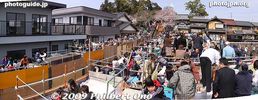
The bleacher seats are sold by auction to the highest bidder. Those next to the steep incline are the most expensive, costing 200,000 yen or higher for one compartment fitting several people. I was in a compartment costing 7,000 yen.Apr 24, 2009
|
|

Stairs to the bleachers which are actually compartments of sitting areas. The bleachers line both sides of the course leading to the steep incline. Apr 24, 2009
|
|

The wall has a notch in the middle for the horse to leap up and over. Inabe Shrine's Ageuma ceremony is older than Tado Shrine's. The festival was started in 1192 by the local castle lord and shrine priest to strengthen the spirit of the youth.Apr 24, 2009
|
|

This earthen wall looks like 2 or 3 meters high. This festival is unique to Mie Prefecture. A similar and much more crowded Ageuma ceremony is held at Tado Shrine also in Mie and not far from Inabe Shrine.Apr 24, 2009
|
|

In 1203, the steep embankment was built and the Ageuma and yabusame ceremonies were held. Along the short galloping course up to the steep incline, makeshift bleachers for spectators are built for the festival.Apr 24, 2009
|
|

On both sides are special spectator seating (decorated in red/white) for the shrine priests and VIPs. We did not see any riders or horses get injured this day. These photos were taken on April 5, 2009.Apr 24, 2009
|
|

This is what the steep incline looks like from the other side. The galloping horse must manage to leap up and over the steep wall called the Agezaka (上げ坂).Apr 24, 2009
|
|

The end of the slope where the horse is to leap over the steep earthen wall. Cherry trees accent the steep incline. The horse gallops and full speed for about 500 meters before encountering this steep incline.Apr 24, 2009
|
|

The festival's main event is the Ageuma (Leaping or Rising Horse) ceremony held 12 times on Sat. and six times on Sun. One of the horses to be used. The Ageuma is unique to Mie and started here at Inabe Shrine.Apr 24, 2009
|
|

The Ageuma or Leaping Horse ceremony is only one of the religious ceremonies held during the Oyashiro Festival. The god of wooden architecture is one of the gods Inabe Shrine worships. Carpenters from this area built Horyuji and Todaiji in Nara.Apr 24, 2009
|
|

Inabe Shrine, where the Oyashiro Matsuri or Ageuma festival is held on the first Sat. and Sun. of April (if it falls on the 1st and 2nd, the festival is held on the 8th and 9th) in Toin, Mie Prefecture. A 15-min. walk from Toin Station on the Sangi Line.Apr 24, 2009
|
|

Kitchen stovesApr 22, 2009
|
|

Small door to the kitchen. People must have been pretty short then.Apr 22, 2009
|
|

Toilets and bathApr 22, 2009
|
|

UrinalApr 22, 2009
|
|

Room inside Basho's childhood home.Apr 22, 2009
|
|

Apr 22, 2009
|
|

A short walk from Ueno Park is the Basho Oseika (芭蕉翁生家) or Basho's childhood home. Iga is the birthplace of Matsuo Basho (1644-1694), and the house where he grew up in still stands.Apr 22, 2009
|
|

Apr 22, 2009
|
|

Apr 22, 2009
|
|

Apr 22, 2009
|
|

The back of the house is Basho's study called Chogetsuken (釣月軒) where he wrote the Kai-ooi (貝おほい) series of poems.Apr 22, 2009
|
|

Inside the Chogetsuken study. 釣月軒Apr 22, 2009
|
|

The house is open to the public as a tourist attraction (admission 300 yen). The house was rebuilt after it being damaged by a large earthquake in 1854.Apr 22, 2009
|
|

Kitchen area with a well on the left and stoves toward the right.Apr 22, 2009
|
|

Water wellApr 22, 2009
|
|

The study is a very simple, yet aesthetic and meditative-looking room.Apr 22, 2009
|
|

Statue of Basho at Ueno-shi Station.Apr 22, 2009
|
|

Apr 22, 2009
|
|

Apr 22, 2009
|
|

Iga-yaki ceramic statue of Basho inside the Haisei-den.Apr 22, 2009
|
|

The Haisei-den was designed to look like Basho in travel clothing. The top roof resembles a hat, and the lower roof resembles his straw raincoat. Cherry blossoms were in bloom.Apr 22, 2009
|
|

Inside the Haisei-den is a ceramic statue of Basho.Apr 22, 2009
|
|

Iga-Ueno's Ueno Park includes this beautiful building called the Haisei-den (俳聖殿), a hall dedicated to Haiku poet Matsuo Basho who was from Iga-Ueno.Apr 22, 2009
|
|

Haisei-den and wisteria in bloom. The Basho Matsuri Festival is a poetry reading held here on Oct. 12.Apr 22, 2009
|
|

The building was designed by architect Ito Chota (1867-1954) (伊東 忠太) who designed numerous shrine and temple buildings in the 1920s and '30s, including Tsukiji Hongwanji temple in Tokyo.Apr 22, 2009
|
|

A short walk from Iga-Ueno Castle and almost next to the ninja house, the Haisei-den was built in 1942 to mark the 300th anniversary of Basho's birth. Apr 22, 2009
|
|
|

Apr 17, 2009
|
|

Storefront shutter with ninja drawings.Apr 17, 2009
|
|

Everywhere you go in Iga-Ueno, you see a ninja motif.Apr 17, 2009
|
|

Ninja shopApr 17, 2009
|
|

Even ninja get thirsty.Apr 17, 2009
|
|

Rope knots hung on roof eaves, etc., were also used for communication.Apr 17, 2009
|
|

Female ninja climbing over a wall.Apr 17, 2009
|
|

Apr 17, 2009
|
|

Ninja doll on a pole.Apr 17, 2009
|
|

Apr 17, 2009
|
|

During April and early May, they hold the annual ninja festa.Apr 17, 2009
|
|

More secret ninja language.Apr 17, 2009
|
|

Bamboo sticks concealing a sword.Apr 17, 2009
|
|

Pepper bombs to blind you.Apr 17, 2009
|
|

Ninja swords.Apr 17, 2009
|
|

Ninjas under cherry blossoms.Apr 17, 2009
|
|

Iga-Ueno Ninja Festa posterApr 17, 2009
|
|

CushionApr 17, 2009
|
|

Female ninjaApr 17, 2009
|
|

Iron clawsApr 17, 2009
|
|

Another ninja museum.Apr 17, 2009
|
|

See many people wearing ninja costumes during the ninja festa.Apr 17, 2009
|
|

Apr 17, 2009
|
|

Where you can rent a ninja costume.Apr 17, 2009
|
|

Making medicine.Apr 17, 2009
|
|

Apr 17, 2009
|
|

Juggling sickles. Having a sickle did not arouse suspicion as it was a common farming tool. But for the ninja, it was an effective weapon.Apr 17, 2009
|
|

Inside ninja museum which is in a former rice warehouse.Apr 17, 2009
|
|

Duel to the death.Apr 17, 2009
|
|

Throwing sickles and shuriken.Apr 17, 2009
|
|

Apr 17, 2009
|
|

Five-colored rice grains used for secret communication.Apr 17, 2009
|
|

Shuriken throwing.Apr 17, 2009
|
|

You have to applaud once in a while.Apr 17, 2009
|
|

Apr 17, 2009
|
|

Apr 17, 2009
|
|

Ninja costumesApr 17, 2009
|
|

Shuruken takes skill to throw.Apr 17, 2009
|
|

Apr 17, 2009
|
|

Nakayama Emiri, a TV personality, tries to throw shuriken.Apr 17, 2009
|
|

Five-colored rice grains used for secret communication.Apr 17, 2009
|
|

Veranda of Iga-ryu Ninja House Apr 17, 2009
|
|

What would a ninja museum be without a display of shuriken?Apr 17, 2009
|
|

Kitchen area in Iga-ryu Ninja House.Apr 17, 2009
|
|

Apr 17, 2009
|
|

Apr 17, 2009
|
|

Apr 17, 2009
|
|

Apr 17, 2009
|
|

KitchenApr 17, 2009
|
|

Iga-ryu Ninja House ninja show.Apr 17, 2009
|
|

Iga-ryu Ninja Museum Apr 17, 2009
|
|

Apr 17, 2009
|
|

Ninjas in the kitchen. We could not go up into the attic as we can in Koka's ninja house in Shiga.Apr 17, 2009
|
|

Apr 17, 2009
|
|

Apr 17, 2009
|
|

Ninja disguisesApr 17, 2009
|
|

Apr 17, 2009
|
|

For an extra 200 yen, you can watch the ninja show right next to the ninja house.Apr 17, 2009
|
|

Ninja swords are short and straight with no curvature.Apr 17, 2009
|
|

Apr 17, 2009
|
|

Lock picksApr 17, 2009
|
|

Thatched-roof of Iga-ryu Ninja House.Apr 17, 2009
|
|

Sword demoApr 17, 2009
|
|

Apr 17, 2009
|
|

Revolving door of Iga-ryu Ninja House Apr 17, 2009
|
|

Flipper-like clogs to walk through swampsApr 17, 2009
|
|

Kitchen in Iga-ryu Ninja House.Apr 17, 2009
|
|

Iga-Ueno really plays up its ninja past. Apr 17, 2009
|
|

Another wall door that leads to the basement tunnel.Apr 17, 2009
|
|

Apr 17, 2009
|
|

Iga-ryu Ninja House is a thatched-roof house whose roof once caught fire in the 1990s. It was rebuilt.Apr 17, 2009
|
|

Hidden floor compartment where they hid their valuables outside the house.Apr 17, 2009
|
|

Ninja paint job on a train.Apr 17, 2009
|
|

This is a staircase concealed as a shelf.Apr 17, 2009
|
|

Emergency escape hatch whose lock can be quickly released with a sheet of paper.Apr 17, 2009
|
|

When you push in the end of this floor plank, it opens up to reveal a sword.Apr 17, 2009
|
|

Inside the Iga-ryu Ninja House.Apr 17, 2009
|
|

Another swinging wall door.Apr 17, 2009
|
|

Sword hidden in the floor.Apr 17, 2009
|
|

Apr 17, 2009
|
|

Kunoichi female ninja guideApr 17, 2009
|
|

Even the trains have a ninja (female) paint job.Apr 17, 2009
|
|
| 1114 files on 5 page(s) |
 |
 |
4 |
|